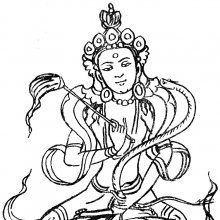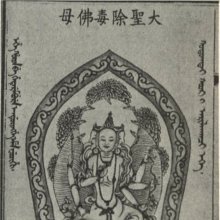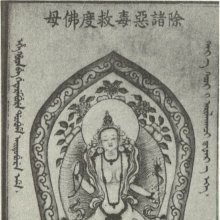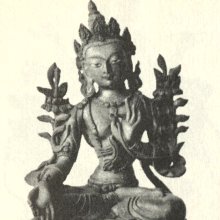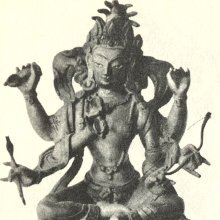Janguli, Jāṅguli, Jāṅgulī, Jaṃgulī, Jaṅgulī, Jamguli: 13 definitions
Introduction:
Janguli means something in Buddhism, Pali, Hinduism, Sanskrit, Jainism, Prakrit. If you want to know the exact meaning, history, etymology or English translation of this term then check out the descriptions on this page. Add your comment or reference to a book if you want to contribute to this summary article.
Images (photo gallery)
(+8 more images available)
In Hinduism
Kavya (poetry)
Source: OpenEdition books: Vividhatīrthakalpaḥ (Kāvya)Jaṃgulī (जंगुली) in Prakrit refers to the “science (against poison) of snakes”, as is mentioned in the Vividhatīrthakalpa by Jinaprabhasūri (13th century A.D.): an ancient text devoted to various Jaina holy places (tīrthas).—See jaṅgulīya snake charmer (Bloomfield 1924 p. 228; Jaos 43 p. 312).

Kavya (काव्य, kavya) refers to Sanskrit poetry, a popular ancient Indian tradition of literature. There have been many Sanskrit poets over the ages, hailing from ancient India and beyond. This topic includes mahakavya, or ‘epic poetry’ and natya, or ‘dramatic poetry’.
In Buddhism
Tibetan Buddhism (Vajrayana or tantric Buddhism)
Source: Wisdom Library: Tibetan BuddhismJāṅgulī (जाङ्गुली) is the name of Vidyārājñī (i.e., “wisdom queen”) mentioned as attending the teachings in the 6th century Mañjuśrīmūlakalpa: one of the largest Kriyā Tantras devoted to Mañjuśrī (the Bodhisattva of wisdom) representing an encyclopedia of knowledge primarily concerned with ritualistic elements in Buddhism. The teachings in this text originate from Mañjuśrī and were taught to and by Buddha Śākyamuni in the presence of a large audience (including Jāṅgulī).
Source: archive.org: The Indian Buddhist Iconography1) Jāṅgulī (जाङ्गुली) refers to one of the female emanations of Akṣobhya, as mentioned in the 5th-century Sādhanamālā (a collection of sādhana texts that contain detailed instructions for rituals).—Jāṅgulī is widely worshipped amongst the Buddhists as a goddess who cures snake-bite and even prevents it. According to a Saṅgīti in the Sādhanamālā she is as old as Buddha himself, and the secret of Jāṅgulī and the mantra for her worship are said to have been imparted to Ānanda by Lord Buddha.
Jāṅgulī (first variety)—[her Colour is white; her Symbol is the snake or vīṇā; her Mudrā is the abhaya]—is described in the Sādhanamālā as follows:—
“The worshipper should meditate himself as Ārya Jāṅgulī who is all white in complexion, four-armed, one-faced, wears the jaṭāmukuṭa and a white scarf. She is decked in white ornaments of gems and white serpents and rests on an animal. She plays on the vīṇā with the two principal hands, carries the white snake in the second left and exhibits the abhaya-mudrā with the second right, and is radiant like the moon”.
Jāṅgulī (second variety)—[Her Colour is green; her Mudrā is the abhaya; her Symbols are the triśūla, peacock’s feathers and the snake.]—is described as follows:—
[The second variety resembles the first in many respects, but the sādhana does not mention the animal-seat or the particular āsana in which Jāṅgulī should stand or sit. The symbols also are different namely, the triśūla, peacock’s feathers and the snake. The mudrā, however, is the same abhaya-mudrā].
Jāṅgulī (second variety, six-armed with three faces)—[Her Colour is yellow; her Vāhana is the snake.]—is described as follows:—
“The worshipper should quickly conceive himself as Ārya-Jāṅgulī, who is yellow in colour, three-faced, and six-armed; Her faces to the right and left are blue and white. She carries the sword, the vajra and the arrow in the three right hands, and the tarjanī with the noose, the blue lotus and the bow in the three left hands; She rests on the expanded hood of the serpent, is decked in celestial ornaments and dress, is resplendent with the auspicious marks of a virgin, and bears the image of Akṣobhya on head. Thus meditating...”
Note: The Hindu goddess Manasā or Viṣaharī has a marked resemblance to the appearance of Jāṅgulī and some of the Dhyānas in the Hindu Tantric works for the goddess distinctly give her the epithet of Jāṅgulī..
2) Jāṅgulī (जाङ्गुली) refers to one of the twelve Dhāriṇīs according to the 11th-century Niṣpannayogāvalī of Mahāpaṇḍita Abhayākara.—Dhāriṇī is a peculiar kind of Buddhist literature which is supposed to generate great mystic power if repeated continually for a long time. They are short works mostly composed of meaningless syllables, sometimes revealing traces of a language now defunct. [...] The deification of books is not unknown in Buddhism. [...] The Niṣpannayogavālī acknowledges altogether twelve Dhāriṇī (viz., Jāṅgulī) deities and gives their descriptions. These Dhāriṇīs look alike when represented and they are usually two-armed, holding the Viśvavajra in the right hand and their special symbols in the left.
Jāṅgulī is described in the Niṣpannayogāvalī (dharmadhātuvāgīśvara-maṇḍala) as follows:—
“Jāṅgulī is white in colour and holds in her left hand buds of poisonous flowers”.
[Her Colour is white; her Symbol is is flowers; she has two arms.—When conceived in the form of deities, the Dhāriṇīs (viz., Jāṅgulī) are endowed with one face and two arms. They all hold in their right hand the double thunderbolt or the viśvavajra, while in the left they carry their own special symbols.—Jāṅgulī-Dhāriṇī is said to be effective against snake poison.]

Tibetan Buddhism includes schools such as Nyingma, Kadampa, Kagyu and Gelug. Their primary canon of literature is divided in two broad categories: The Kangyur, which consists of Buddha’s words, and the Tengyur, which includes commentaries from various sources. Esotericism and tantra techniques (vajrayāna) are collected indepently.
Languages of India and abroad
Sanskrit dictionary
Source: DDSA: The practical Sanskrit-English dictionaryJāṅguli (जाङ्गुलि).—A snake-doctor, a dealer in antidotes (viṣavaidya); मां जाङ्गुलिकमालोक्य महतीं शान्तिमागताः (māṃ jāṅgulikamālokya mahatīṃ śāntimāgatāḥ) Śiva. B.13.44.
Derivable forms: jāṅguliḥ (जाङ्गुलिः).
See also (synonyms): jāṅgulika.
Source: Cologne Digital Sanskrit Dictionaries: Edgerton Buddhist Hybrid Sanskrit DictionaryJāṅguli (जाङ्गुलि).—m., name of a maharṣi: Mahā-Māyūrī 256.30.
--- OR ---
Jāṅgulī (जाङ्गुली).—f. (Sanskrit Lex. id.; [Jaina Māhārāṣṭrī] jaṅguli, AMg. jaṅgolī, id.), (1) the science and art of curing snake-bites: Śikṣāsamuccaya 142.1 °lyāṃ vidyāyāṃ udāhṛtāyāṃ, a snake-charm having been recited; but Transl., p. 139, note 3, reads jāṅgulyā, allegedly ‘with Tibetan’ (which is not cited), and renders when the snake charmer recites this spell against poison; there is a stem jāṅguli, m., snake-charmer, Sanskrit Lex., but this form being fem. would have to be taken as meaning by a female snake-charmer; (2) name of a goddess: Sādhanamālā 177.14 etc.; in 249.5 a personified charm (vidyā) against poison (uttamā viṣanāśanī).
Source: Cologne Digital Sanskrit Dictionaries: Shabda-Sagara Sanskrit-English DictionaryJāṅguli (जाङ्गुलि).—m.
(-liḥ) A snake-catcher, a dealer in antidotes. E. jaṅgula, and iñ aff. or gama-yaṅ luk vā ḍuli . viṣavaidye .
Source: Cologne Digital Sanskrit Dictionaries: Monier-Williams Sanskrit-English Dictionary1) Jāṅgulī (जाङ्गुली):—[from jāṅgula > jāṅgali] f. idem, [cf. Lexicographers, esp. such as amarasiṃha, halāyudha, hemacandra, etc.] ([varia lectio] galī)
2) [v.s. ...] Durgā (Gaurī, [Demetrius Galanos’s Lexiko: sanskritikes, anglikes, hellenikes]), [cf. Lexicographers, esp. such as amarasiṃha, halāyudha, hemacandra, etc.]
3) [v.s. ...] Luffa acutangula, [Horace H. Wilson]
4) Jāṅguli (जाङ्गुलि):—[from jāṅgali] m. a snake-charmer, [cf. Lexicographers, esp. such as amarasiṃha, halāyudha, hemacandra, etc.]
Source: Cologne Digital Sanskrit Dictionaries: Yates Sanskrit-English DictionaryJāṅguli (जाङ्गुलि):—(liḥ) 2. m. A snake-catcher.
Source: DDSA: Paia-sadda-mahannavo; a comprehensive Prakrit Hindi dictionary (S)Jāṅguli (जाङ्गुलि) in the Sanskrit language is related to the Prakrit word: Jaṃguli.
[Sanskrit to German]
Sanskrit, also spelled संस्कृतम् (saṃskṛtam), is an ancient language of India commonly seen as the grandmother of the Indo-European language family (even English!). Closely allied with Prakrit and Pali, Sanskrit is more exhaustive in both grammar and terms and has the most extensive collection of literature in the world, greatly surpassing its sister-languages Greek and Latin.
Prakrit-English dictionary
Source: DDSA: Paia-sadda-mahannavo; a comprehensive Prakrit Hindi dictionaryJaṃguli (जंगुलि) in the Prakrit language is related to the Sanskrit word: Jāṅguli.
Prakrit is an ancient language closely associated with both Pali and Sanskrit. Jain literature is often composed in this language or sub-dialects, such as the Agamas and their commentaries which are written in Ardhamagadhi and Maharashtri Prakrit. The earliest extant texts can be dated to as early as the 4th century BCE although core portions might be older.
Kannada-English dictionary
Source: Alar: Kannada-English corpusJaṃguli (ಜಂಗುಲಿ):—[noun] = ಜಂಗುಳಿ [jamguli].
--- OR ---
Jaṃguḷi (ಜಂಗುಳಿ):—
1) [noun] a large number of people, animals, things etc. being together; a crowd.
2) [noun] the common people; the masses.
--- OR ---
Jaṃguḻi (ಜಂಗುೞಿ):—[verb] = ಜಂಗುಜರಿ [jamgujari].
--- OR ---
Jāṃguḷi (ಜಾಂಗುಳಿ):—
1) [noun] = ಜಾಂಗುಲ - [jamgula -] 2.
2) [noun] the state of happiness; joy.
Kannada is a Dravidian language (as opposed to the Indo-European language family) mainly spoken in the southwestern region of India.
See also (Relevant definitions)
Starts with: Jamguliga, Jamguligadir, Jamgulijasa, Jamgulimohi, Jamgulisu, Jangulika, Janguliya.
Ends with: Janajamguli.
Full-text: Jangulika, Jangali, Sumbhalika, Janguliya, Varadatara, Varada, Dharini, Mahasri, Tara.
Relevant text
Search found 5 books and stories containing Janguli, Jāṅguli, Jāṅgulī, Jaṃgulī, Jaṅgulī, Jamguli, Jaṃguli, Jaṅguli, Jaṃguḷi, Jaṅguḷi, Jaṃguḻi, Jaṅguḻi, Jāṃguḷi, Jāṅguḷi; (plurals include: Jangulis, Jāṅgulis, Jāṅgulīs, Jaṃgulīs, Jaṅgulīs, Jamgulis, Jaṃgulis, Jaṅgulis, Jaṃguḷis, Jaṅguḷis, Jaṃguḻis, Jaṅguḻis, Jāṃguḷis, Jāṅguḷis). You can also click to the full overview containing English textual excerpts. Below are direct links for the most relevant articles:
The Indian Buddhist Iconography (by Benoytosh Bhattachacharyya)
Figure 137 - Emanations of Akṣobhya: Jāṅgulī (snake-bite Goddess)
Figure 169 - Emanations of Amoghasiddhi: Mahāśrī Tārā
Figure 166-168 - Emanations of Amoghasiddhi: Khadiravaṇī Tārā
Trishashti Shalaka Purusha Caritra (by Helen M. Johnson)
Appendix 5.2: new and rare words < [Appendices]
Stupas in Orissa (Study) (by Meenakshi Chauley)
The gods of northern Buddhism (by Alice Getty)
Related products
